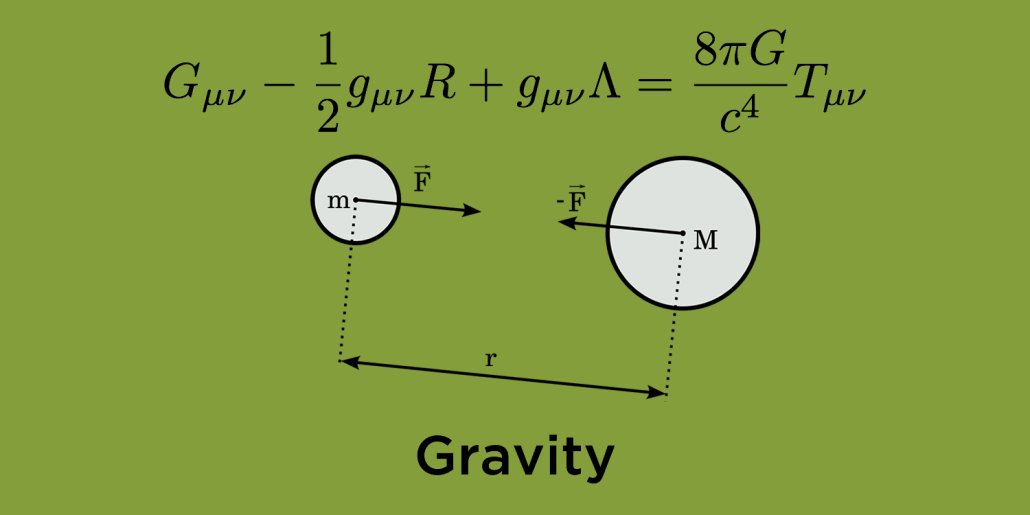

Gravity is perhaps the best known of the four fundamental forces. It’s also the one that’s easiest to understand. At a basic level, gravity is simply the mutual attraction between any two masses. It’s the force that lets the Sun hold the planets in their orbits, and the force that holds the Earth to you. The force is always attractive, and the strength of the force between two masses depends inversely on the square of their distances, making it an inverse square force. But gravity’s simplicity is just a veneer that hides a deeply subtle and complex phenomenon.
When Newton proposed his model of universal gravity, one criticism of the model was how gravity could act at a distance. How does the Moon “detect” the presence of Earth and “know” to be pulled in Earth’s direction? A few ideas were proposed, but never really panned out. Since Newton’s model was so incredibly accurate, the action-at-a-distance problem was largely swept under the rug. Regardless of how masses detected each other, Newton’s model let us calculate their motion. Another difficulty came to be known as the 3-body problem. Calculating the gravitational motion of any two masses was straight forward, but the motion of three or more masses was impossible to calculate exactly. The motion could be approximated to great precision, and was even used to discover Neptune, but an exact, general solution for three masses would never be found.
Newton’s idea was simple, but it’s application was complex.
In the early 1900s, we found that gravity wasn’t a force at all. In Einstein’s model, gravity isn’t a force, but rather a warping of spacetime. Basically, mass tells space how to bend, and space tells mass how to move. General relativity isn’t just a mathematical trick to calculate the correct forces between objects, it makes unique predictions about the behavior of light and matter, which are different from the predictions of gravity as a force. Space really is curved, and as a result objects are deflected from a straight path in a way that looks like a force.

Credit: John Baez
But despite its simple approximation as a force, and its beautifully subtle description as a property of spacetime, we’ve come to realize over the past century that we still don’t know what gravity actually is. That’s because both Newton’s and Einstein’s models of gravity are classical in nature. We now know that objects have quantum properties, with particle-like and wave-like behaviors. When we try to apply quantum theory to gravity, things become complicated and confusing. In most quantum theory, quantum objects exist within a background framework of space and time. Since gravity is a property of spacetime itself, fully quantizing gravity would require a quantization of space and time. There are several models that attempt this, but none of them have yet achieved a fully quantum model.
Usually our current understanding of gravity is just fine. We can accurately describe the motions of stars and planets. Seemingly odd predictions such as black holes and the big bang have been confirmed by observation. Every experimental and observational test of general relativity has validated its accuracy. Large objects with strong gravity can be described just fine by classical gravity. For small objects with weak gravity we our approximate quantum gravity is good enough. The problem comes when we want to describe small objects with strong gravity, such as the earliest moments of the big bang.
Without a complete theory of quantum gravity, we won’t fully understand the earliest moment of the universe. We know from observation that the early observable universe was both very small and very dense. From general relativity this would imply that the universe began as a singularity. Most cosmologists don’t think the universe actually began as a singularity, but without quantum gravity we aren’t exactly sure. Even if we put the quantum aspects of gravity aside, there is still a part of gravity we don’t understand. Within general relativity it is possible to have a cosmological constant. Adding this constant to Einstein’s equations causes the universe to expand through dark energy, just as we observe. While general relativity allows for a cosmological constant, it doesn’t require one. The cosmological constant agrees with what we observe, but there are other proposed models for dark energy that agree as well (at least for now). If dark energy is really due to the cosmological constant, then the constant must be very close to zero, at about 10-122. Why would a constant be so incredibly close to zero? Why does it even exist when general relativity doesn’t require it?
We don’t know, and without that understanding, both the origin and fate of the universe remain mysteries.
Provided by Brian Koberlein at One Universe at a Time